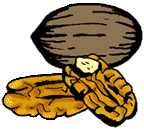  
2004 Camp Verde Pecan Show - November 26, 2003
Jeff Schalau, County Director, Agent, Agriculture & Natural Resources
Arizona Cooperative Extension, Yavapai County
Pecans are starting to ripen in the Verde Valley and this year we had a great pecan crop. I encourage all that have pecan to enter a sample in the 2004 Camp Verde Pecan Show. The Pecan Show is part of the Camp Verde Pecan and Wine Festival that will take place February 14 and 15, 2004. This will be the fourth year of this fantastic festival and it keeps getting better each year. Along with seeing how your pecans compared with other Verde Valley growers, you can taste and purchase Arizona wines and pecan products, eat pecan pie, listen to live bluegrass music, purchase antiques, and have a great time doing it. Yavapai County Master Gardeners will also be available to answer gardening questions.
At a pecan show, a sample of 40 nuts taken from a single tree is judged based on: (1) size, (2) percent kernel (the percent of kernel in proportion to the whole nut), (3) kernel color (actual color of the kernel with bright yellow being ideal), (4) in-shell appearance, (5) uniformity (size and shape), (6) number of whole kernel halves after shelling, and (7) degree of insect damage. The first three of all the characteristics listed above are the most important and are used by judges in determining winners in each class in most cases. Characteristics four through seven are used when large numbers of samples are being judged. The following suggestions will aid you in collecting and selecting the best pecans for the show.
- Select nuts from young trees when possible. Young trees have greater vigor and produce larger, better-filled nuts.
- Select nuts from trees with lighter crops and/or fewer nuts per cluster. Heavy crops cause excessive drain on the tree resulting in poorer quality nuts.
- Harvest pecans immediately following drop. Generally, pecans that fall early are of better quality than those exposed to the elements for longer periods.
- Do not pick nuts from the shuck if the shuck is green or the nut is still attached to the shuck. This means that the pecan has not dried properly and the shell of the nut will turn a light color, which is abnormal and viewed as undesirable by judges. These nuts will also contain excessive moisture at the time of cracking and shelling.
- After collecting pecan samples, leave them at room temperature for two or three days so that they will dry and be suitable for shelling. After they have dried, place them in a cool environment (refrigerator) until they are submitted to the show. The sample can be placed in a cool, dry environment for a couple of weeks if air circulation is adequate. Make sure that nuts are open to the air and not clustered together.
- If there is more than one tree of a particular variety to select a sample from, crack and shell a few nuts from each tree and observe the interior quality. Look for solid, well-filled kernels as opposed to kernels with openings in and around the kernel. Also, observe the color of the kernel to check for stink bug damage (black spot). If damage is evident, select another tree or location if possible.
- Do not alter the physical in-shell appearance of the nut such as polishing or rubbing. Again, avoid nuts that show evidence of insect damage on the shell.
- If time permits, determine the weight of each individual pecan for entry so that a uniform sample will be selected. The heaviest nuts should be used for the sample. It is better to have a uniform sample than an assortment of large and small nuts. Check also for abnormal shape, cracks, splits, or blemishes.
- Harvest sample pecans from healthy undamaged areas of the tree. Sometimes a portion of a tree will be defoliated by a pest or environmental factor prior to nut maturity. This causes poor quality.
- A qualified sample consists of 40 nuts. It is better to enter 41 or 42 nuts to be sure of your count because sometimes a nut can be lost during handling. Entries consisting of 39 or less nuts are disqualified.
- Prevent nuts from getting wet prior to harvest and selection. If a pecan gets wet, it will cause the kernel to darken and adversely affect the natural in-shell appearance of the nut.
Starting February 9, 2004, entries can be brought to the Camp Verde Chamber of Commerce or the Camp Verde Parks and Recreation Department. All samples must be submitted by 5 PM on February 12, 2003. If you want to buy fresh, local pecans, Dick Tinlinís Summer Place in Camp Verde is also an excellent source (call 520-567-5202 for availability). I hope to see you at the festival.
The University of Arizona Cooperative Extension has publications and information on gardening and pest control. If you have other gardening questions, call the Master Gardener line in the Cottonwood office at 646-9113 ext. 14 or E-mail us at mgardener@verdeonline.com and be sure to include your address and phone number. Find past Backyard Gardener columns or submit column ideas at the Backyard Gardener web site: http://ag.arizona.edu/yavapai/anr/hort/byg/.
Back to Backyard Gardener Home Page
|
